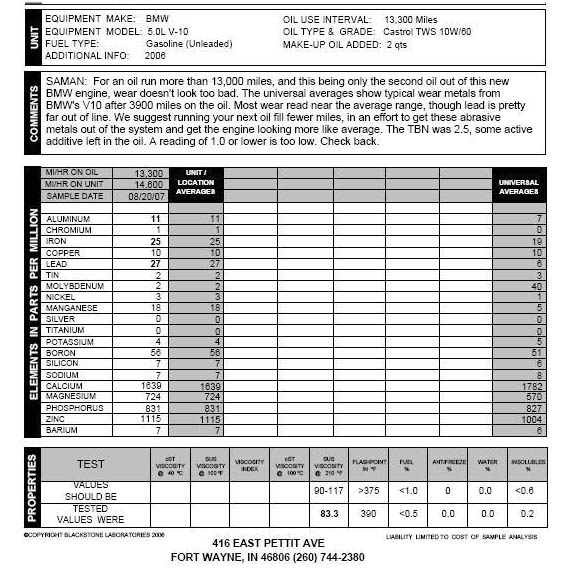This board has two groups that get UOA's done - the perfectionists trying to get the lowest wear and the correctionists ensuring that their engines are running normally. Fortunately for all concerned, BOTH groups end up with more efficient, lower polluting engines. Nobody loses, as far as I can tell.
A UOA tells you the condition of the oil, not the engine.
The wear numbers, the fuel, water, antifreeze (glycol) and silicon numbers are just pointers to the effects of contamination by chemicals that aren't supposed to be there, which usually means that mechanical work is needed.
So it won't tell if your engine will fail soon, but it will tell you if there are problems that, if not unrepaired, could cost a lot to repair later.
Quote:
This is deceptive, since the oil capacity is 13L, or almost 14 Qts. If you wanted to compare this to a Prius, which has a 4 Qt capacity, you'd have to multiply the V10 numbers by 3.5. If you wanted to correct for engine complexity by normalizing for the number of cylinders, you could divide by 2.5. Still, wear is significantly higher.
I really didn't know that there is such math involved with the UOAs. The numbers, except for lead, are not crazy, but of course if you do the math you are suggesting they would be really over the top.
I really wonder what the whole point of the UOA deal is. I think it has become more of a hobby than anything else.
Can somebody please provide me some info where the UOAs looked bad and the car broke down within a 6 months? At the same time is there anybody that can show a bad UOA, suggestions on what to fix and the numbers improving.
Please do if you can, because I have been getting very skeptical about this whole deal. Don't get me wrong, I enjoy reading these forums and testing out new things, but sometimes it does seem like a waste of time and money.
Sticking with manufacturer recommended intervals and approved oils (in my case 5000 miles and VW 502 00 oil) I would think the car would run fine for quite some time.
I am aware of RS4 stats and the RLI info that is on top of the forum and that is a great example of how to lower wear numbers. I am sure that the money that was invested in the research was great as well.
Thanks guys



